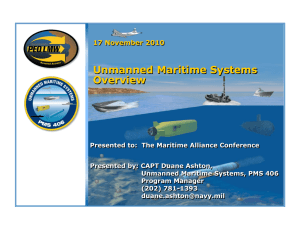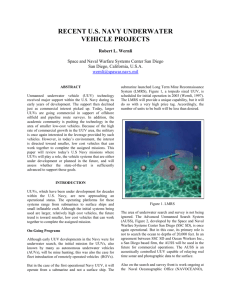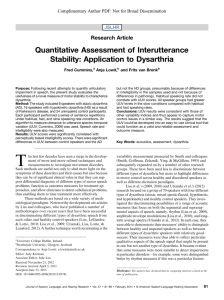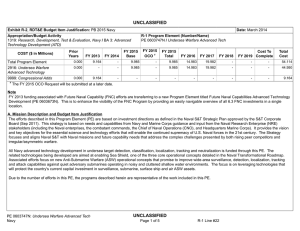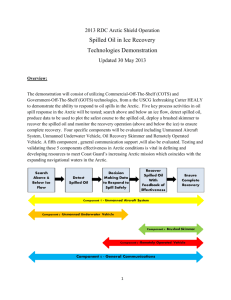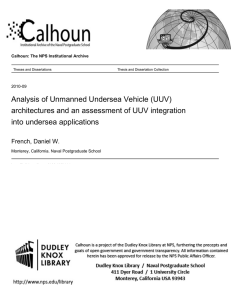A BLUEPRINT FOR THE USE OF UNMANNED
advertisement
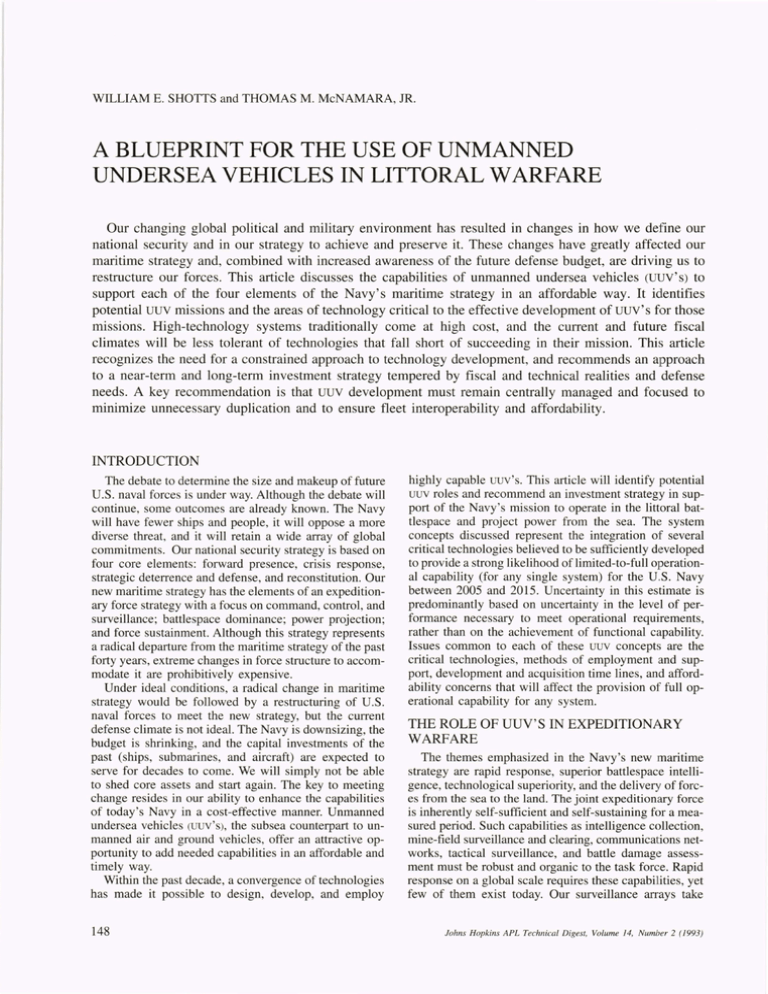
WILLIAM E. SHOTTS and THOMAS M. McNAMARA, JR. A BLUEPRINT FOR THE USE OF UNMANNED UNDERSEA VEHICLES IN LITTORAL WARFARE Our changing global political and military environment has resulted in changes in how we define our national security and in our strategy to achieve and preserve it. These changes have greatly affected our maritime strategy and, combined with increased awareness of the future defense budget, are driving us to restructure our forces. This article discusses the capabilities of unmanned undersea vehicles (UUY'S) to support each of the four elements of the Navy's maritime strategy in an affordable way. It identifies potential UUY missions and the areas of technology critical to the effective development of uuv' s for those missions. High-technology systems traditionally come at high cost, and the current and future fiscal climates will be less tolerant of technologies that fall short of succeeding in their mission. This article recognizes the need for a constrained approach to technology development, and recommends an approach to a near-term and long-term investment strategy tempered by fiscal and technical realities and defense needs. A key recommendation is that UUY development must remain centrally managed and focused to minimize unnecessary duplication and to ensure fleet interoperability and afford ability . INTRODUCTION The debate to determine the size and makeup of future U.S. naval forces is under way. Although the debate will continue, orne outcomes are already known. The Navy will have fewer ships and people, it will oppose a more diverse threat, and it will retain a wide array of global commitments. Our national security strategy is based on four core elements: forward presence, crisis response, strategic deterrence and defense, and reconstitution. Our new maritime strategy has the elements of an expeditionary force strategy with a focus on command, control, and surveillance; battlespace dominance; power projection; and force sustainment. Although this strategy represents a radical departure from the maritime strategy of the past forty years, extreme changes in force structure to accommodate it are prohibitively expensive. Under ideal conditions, a radical change in maritime strategy would be followed by a restructuring of U.S. naval forces to meet the new strategy, but the current defense climate is not ideal. The Navy is downsizing, the budget is shrinking, and the capital investments of the past (ships, submarines, and aircraft) are expected to serve for decades to come. We will simply not be able to shed core assets and start again. The key to meeting change resides in our ability to enhance the capabilities of today's Navy in a cost-effective manner. Unmanned undersea vehicles (UUV'S), the subsea counterpart to unmanned air and ground vehicles, offer an attractive opportunity to add needed capabilities in an affordable and timely way. Within the past decade, a convergence of technologies has made it possible to design, develop, and employ 148 highly capable uuv's. This article will identify potential UUV roles and recommend an investment strategy in support of the Navy's mission to operate in the littoral battlespace and project power from the sea. The system concepts discussed represent the integration of several critical technologies believed to be sufficiently developed to provide a strong likelihood of limited-to-full operational capability (for any single system) for the U.S. Navy between 2005 and 2015. Uncertainty in this estimate is predominantly based on uncertainty in the level of performance necessary to meet operational requirements, rather than on the achievement of functional capability. Issues common to each of these uuv concepts are the critical technologies, methods of employment and support, development and acquisition time lines, and affordability concerns that will affect the provision of full operational capability for any system. THE ROLE OF UUV'S IN EXPEDITIONARY WARFARE The themes emphasized in the Navy's new maritime strategy are rapid response, superior battlespace intelligence, technological superiority, and the delivery of forces from the sea to the land. The joint expeditionary force is inherently self-sufficient and self-sustaining for a measured period. Such capabilities as intelligence collection, mine-field surveillance and clearing, communications networks, tactical surveillance, and battle damage assessment must be robust and organic to the task force. Rapid response on a global scale requires these capabilities, yet few of them exist today. Our surveillance arrays take Johns Hopkins APL Technical Digest, Volume 14, Number 2 (1993) years to develop and deploy; our mine countermeasures assets are too slow to keep up with a battle group; our amphibious operating-area intelligence is gathered through high-risk sea-air-Iand operations, and our effectiveness is limited by a plethora of unintegrated communications systems. Between now (at this writing) and the end of CY94, the Navy will take delivery of forty-four ships, including cruisers, submarines, auxiliaries, and an aircraft carrier. Because of the nature of the shipbuilding process, these ships were born during the Cold War and are expected to remain in service for thirty to fifty years. They represent a significant capital investment, yet because of warfighting differences between global and regional conflicts, they do not comfortably conform to the needs of the expeditionary force. Uuv's offer force planners the ability to achieve conformance by adding critically needed new capabilities to existing air, surface, and submarine platforms in an affordable way. By virtue of their relative size (sufficiently small for air transport), UUy systems can increase the mobility and responsiveness of a modern naval expeditionary force. They can be pre-staged around the world with minimal impact on the naval logistics infrastructure, can be placed in theater via air transport, and can quickly be placed in operation by a broad variety of platforms. In addition, UUY systems can provide flexible, effective, low-cost, and low-risk solutions to many of the critical needs in each of the four maritime strategy areas, as discussed in the following sections. UUV SYSTEMS FOR COMMAND, CONTROL, AND SURVEILLANCE Themes of superior battlespace intelligence and force connectivity underlie the operational capabilities needed for command, control, and surveillance. UUY'S represent the integration of technologies that can transform these themes into reality. Forward-deployed UUy'S can extend the horizon of a ship or battle force into areas that may be denied to manned platforms. Moreover, UUy'S can economically provide the critically needed capabilities for covert shallow-water surveillance, undersea battlespace management, and covert mapping and mine identification. Shallow-Water Surveillance A uuv can be equipped with an array of sensors able to detect threat submarines and surface ships at short ranges in littoral waters. The UUy would navigate over a predetermined course and deploy an array of multiphenomena, low-cost, and disposable sensors with sufficient sensitivity and noise immunity to be useful as a trip-wire barrier. Acoustic and electromagnetic sensors (ideally configured in a long, small-diameter optical fiber) would be deployed on the bottom along a "barrier" front, and the uuv would monitor array signals at some standoff distance. The uuv would also provide power, preprocessing, localization of threats, and communications. Raw or processed data would be communicated via RF links to satellites or over the horizon. This system would provide early, covert, and sustainable monitoring of platforms egressing ports, the probable identification Johns Hopkins APL Technical Digest. Volume 14. Number 2 (1993) of mining operation locations, and potentially the location of mine-free transit lanes. A single uuv system could provide surveillance over a thirty-nautical-mile front for a period of ninety days before requiring replenishment. If the uuv system were launched and recovered from a submarine, then continuous, covert surveillance could be achieved. Undersea Battlespace Management Network Expanding the concept of a uuv-deployed surveillance array leads to the concept for an undersea battlespace management network, which may be described as a network ofuuv surveillance arrays (as described previously) employed to provide covert surveillance of the entire littoral undersea battlespace. The arrays would be deployed to divide the littoral undersea battlespace into cells, similar to the division of submerged operating areas off the continental United States. Information from each of the uuv arrays could be transferred to a submerged submarine acting as an undersea battlespace management center in deeper water, or to surface forces via the RF or satellite communications links. Because of the multiplicity of sensor arrays, power sources, and processors, the network would be robust (i.e., not susceptible to single-point failures). The concept also provides flexibility and mobility to operational commanders through its area coverage, cell resolution, and geographic location (achieved by varying the array length, spacing, and quantity of arrays). The operation and deployment of uuv systems from a submarine would provide covert, early, and sustained surveillance. Both friendly and hostile submarines could be detected and localized upon entering or departing a cell. At the onset of hostilities, antisubmarine warfare assets to prosecute the threat submarines could be directed to the appropriate cell by the battle-group commander. Covert Mapping and Mine Identification To achieve the most effective results, the two previously described uuv system concepts assumed the advantage of early presence. Early presence for indication, warning, and response in littoral warfare will not always be possible, however. As a consequence, the uuv can be effective in the covert survey and mapping of potential operating areas and minable waters. This concept is currently being demonstrated in the Advanced Research Projects AgencylNavy Mine Search System; additional operational capability is anticipated in the Navy's Submarine Offboard Mine Search System. Both systems provide uuv mine detection and avoidance to escort a ship through minable waters, and autonomous search and survey of a large undersea area. Extended sensor measurements are possible to achieve more detailed UUy survey and mapping products such as tactical oceanographic information. UUV SYSTEMS FOR BATTLESPACE DOMINANCE Currently, the Navy's ability to locate, classify, and destroy threats in shallow water reliably and quickly poses a potential roadblock to the achievement of battlespace dominance. The uuv can provide affordable capabilities in littoral antisubmarine warfare (identifica149 W. E. Shotts and T. M. McNamara, Jr. tion, localization, and targeting), shallow-water mine survey and identification, and mine neutralization. high probability of clearance at a very rapid rate and within a very short time interval before AOA use. Littoral Antisubmarine Warfare UUV SYSTEMS FOR POWER PROJECTION The management of forces operating in the foreshortened undersea battlespace is critical in a littoral environment. Accordingly, the rapid localization and identification of a submarine in the constrained battlespace is essential to prevent fratricide and to ensure a high probability of destroying the threat submarine. By exploiting its size, stealth, and maneuverability, a uuv could be used to "tag" a threat submarine covertly before the onset of hostilities. The tagging, in the harbor or upon the submarine's egress from port, would allow friendly forces to monitor covertly the location and specific operating characteristics of the threat submarine beyond the littoral battlespace. Additionally, the tag would allow quick localization of the submarine just before the delivery of ordnance. The tag device might sense depth, speed, heading, and position information and provide these data at discrete intervals to a satellite, or over the horizon to friendly forces. In the process of attaching the tag, the uuv could visually image selected areas of the platform, thus providing the system with more certain classification and identification data. (Imaging data would later be transmitted to friendly forces for intelligence purposes and confIrmation of a successful tag.) Upon selected active acoustic interrogation, the tag device would reply, thereby indicating the submarine's location. Although the tagging operation itself is not considered to be rapid, if performed covertly and early, it would provide rapid and effective antisubmarine warfare capabilities at the onset of hostilities. Uuv systems may support the projection of power ashore through both direct and indirect means. They can be effective in undersea battle damage assessment and decoying and disruption. Moreover, cross-platform portability, commonality in training, and commonality in logistic support enable uuv's to sustain needed capabilities in the battle area. Shallow-Water Survey and Identification Dominance of the littoral undersea battlespace must extend from the deep sea to the shore. The ability to identify and respond to the undersea mine threat in all water depths must therefore be improved. Uuv's equipped with covert high-resolution sonars, nonacoustic sensors, and imaging systems can autonomously survey potentially minable waters. They could return with sufficient information to generate detailed bathymetric maps indicating the high-probability positions of mines and mine fields and selected high-resolution visual images of the highest probability targets. These data would be rapidly processed to support the planning of amphibious assault operations. With a properly configured UUV, this capability may be provided in waters as shallow as twenty-five feet. Mine Neutralization The execution of amphibious assault operations requires an acceptable level of mine clearance to provide an assault lane to the beach. Uuv's could be configured to reacquire the mines in previously surveyed Amphibious Objective Area (AOA) lanes and covertly place remotely activated or timed neutralization charges. These charges would remain with the mines until activated before the advance of MCM or AOA forces. The neutralization operation, when performed in conjunction with the autonomous shallow-water survey, would provide a 150 Undersea Battlespace Damage Assessment During littoral warfare, it will be vitally important to assess quickly and accurately the extent of the enemy's battle damage and its ability to counterstrike. The submarine losses of the enemy may be difficult to confirm, however, and the confirmation of kills may be so lacking as to slow or halt the projection of power ashore. Uuv's can assess the condition of bottomed submarines during ongoing hostilities without risk to manned platforms. They would also provide an early assessment for the planning of rescue or recovery operations for our own submarines. Decoy and Disruption Uuv's could provide the battle-group commander with a mobile platform flexible enough to emulate several operations to decoy or disrupt the enemy's activities. Such a capability could range from the high-fidelity emulation of a submarine for stimulating hostile antisubmarine warfare forces to the coastal ingress of the uuv for communications decoying/jamming, initiating explosions, and alerting and deceiving swimmer or coastal defense systems. UUV EMPLOYMENT ISSUES The uuv system concepts described previously possess several common characteristics that must be addressed when considering the employment of uuv's as systems in expeditionary forces. These characteristics are operational requirements; launch, recovery, and replenishment; and maintenance and training. Operational Requirements The definition of operational requirements represents a significant consideration in the development of a uuv system. The utility and effectiveness of uuv's in littoral warfare are limited by design features such as size, mission payload, speed, and endurance. Experience has shown that these features will determine both the technical performance and the cost of a system. Consequent1y' it is vitally important to understand the basis of the operational need, particularly where joint warfare is anticipated. Performance requirements taking into account host platform constraints, communications, speed, covertness, mobility, depth, endurance, and degree of autonomy should be addressed in a disciplined manner so that the relationships of performance and cost to the operational requirements can be understood. Trade-offs Johns Hopkins APL Technical Digest, Volume 14, Number 2 (1993) Blueprint for Use of Unmanned Undersea Vehicles in Littoral Warfare between joint systems operations, operational effectiveness, and affordability must be considered to ensure balance in system development. Mission needs must be balanced with cost and technical performance. Launch, Recovery, and Replenishment Although uuv 's are deemed affordable compared with the cost of a capital ship, they represent a significant investment in technology. Therefore, it appears that for the near term, it will be cost-effective for most uuv's to be recovered for recycling and replenishment rather than to be expended. Recovery of uuv's, predominantly for reasons of cost, may also be necessitated by the need to recover stored information. Thus, a launch and recovery capability is required that is flexible, mobile, simple to operate and maintain, reliable, and compatible with the host platform. The acquisition community will strive to provide a launch and recovery capability that minimally affects the host. To accomplish that, the operational community must participate in the identification of critical platform characteristics and their sensitivity to design requirements. Recovery implies the replenishment and recycling of the vehicle at the operational level. The power source may be replenished, data may be removed, and any expendable, consumable, or disposable elements of the system may be replaced. Additionally, turnaround of a vehicle would require the exercise of built-in test features to ensure the reliability of the uuv for subsequent operations. Here again, the operational community needs to consider carefully the degree of impact permitted on a particular operational host to the uuv. Maintenance and Training The final significant consideration for employing uuv systems deals with their ability to extend the manned platform'S understanding of, and influence on, its operating environment. This capability requires the support of trained personnel to operate and maintain the systems, many of which are composed of highly technical and complex elements whose integrated operation must be expressed in relatively simple and understandable terms to be useful to both the operator and maintenance personnel. Training may be performed on simulators, in the classroom, on the host platform in port, and at sea. The operators make up a vital element of the uuv system, so proficiency training will be essential to ensure the readiness to undertake a mission. The operational community will playa predominant role in defining the skill level and quantity of manpower available to support the uuv. Each of these issues must be carefully considered in balance with the technical performance objectives at the initiation of systems development and program planning to ensure that the fielded systems provide an effective littoral warfighting capability. Joint definition of the issues between the operational and acquisition communities is imperative to the achievement of that capability. CRITICAL UUV TECHNOLOGY AREAS Each of the uuv concepts supporting the maritime expeditionary role possesses several common subsystems Johns Hopkins APL Technical Digest, Volume 14, Number 2 (1993) that have similar functional characteristics across the various missions. The common subsystems and their related technology and applications are the following: 1. Power and propulsion to achieve endurance and speed requirements. 2. High-data-rate communications to connect the uuv with the host platform in a reliable way. 3. Acoustic, electric, and magnetic quieting to achieve and preserve stealth. 4. Navigation to achieve accurate positioning and recovery. 5. Fault tolerance and localization to provide reliable and maintainable systems. 6. Control and processing to permit autonomous mission planning and decisions. 7. Miniaturization to improve vehicle packaging and payload capabilities. 8. Sensors to provide signal acquisition capabilities over a broad range of environmental and operational conditions. Generally speaking, uuv missions are determined by the requirement for long endurance and stealth rather than high speed. Launch and recovery issues will also constrain vehicle size and thereby limit the endurance achievable from the vehicle. Power source technologies for uuv's will need a predominant focus on high energy densities and relatively low delivery rates. Limitations on energy density will require practicable power source technologies to be capable of routine energy replenishment. After the desire to reduce risk to manned platforms, covertness is probably the chief consideration determining the utility of a uuv in performing a mission. Vehicle quieting therefore will nearly always be required for uuv systems in littoral warfare. Technological developments in this area may borrow heavily from lessons learned in the submarine community, but may also rely on developments dedicated to uuv applications, specifically those targeted for achieving the desired performance in smalldiameter, low-speed vehicles. Because many littoral warfare missions for uuv's require the vehicle to be positioned to a geodetic reference frame, and because the ability of the uuv to execute its mission (autonomously or semi-autonomously) depends on its estimate of where it is operating, its navigational suite will have to provide greater navigational accuracy than has been traditional with attack submarines operating in deep water. Although technologies to achieve the required navigational accuracies are advancing, the challenge will be to provide the navigation performance within an instrument small enough and light enough to fit the uuv limitations of volume, weight, and power. Ideally, navigators that can achieve the needed accuracies without requiring external input or emanation of external signals are desired and would be the most reliable across operating environments. The importance and utility of the missions selected for uuv's and the autonomous or semi-autonomous nature of their operations will require uuv systems to have a high degree of fault tolerance. As increases in vehicle endurance result in expanded missions and capabilities, the demand on the system's fault tolerance and in-water reli151 W. E. Shotts and T. M. McNamara, Jr. ability will increase. Further, the ability to rapidly identify and localize faults is necessary for the rapid repair and turnaround characteristics desired in a uuv system. Although the degree to which autonomous control is required varies from mission to mission, advances in intelligent processing architectures have significantly contributed to the broadening of uuv roles and missions from those of a simple remotely operated vehicle and a "programmed" vehicle. Significant effort has been expended to provide autonomous processing of high-bandwidth signals; automated detection and classification algorithms and architectures have been developed and are being improved; and autonomous control in unstable and dynamic environments, and in the presence of unexpected events, is currently being explored. The uuv will carry a payload limited by the margin associated with neutral buoyancy, internal volume, and nominal weight. Miniaturization of components routinely used on uuv's is necessary to reduce the volume, weight, and power required for the uuv's basic functions (i.e., to expand the margin available for the uuv's mission payload). Advances in this area are required at a rate equivalent to those in the autonomous control and processing technologies. The associative nature of these technology areas can be expected to provide additional volume for the increasing payload demands that will occur as uuv missions increase in utility and/or autonomy. The primary payload of uuv's has been, and will probably continue to be, sensors that extend the horizon and awareness of the battlespace for manned platforms. Just as the basic uuv components must be miniaturized to improve the vehicle's capacity to house sensors, the sensors themselves must be developed with an awareness of the uuv's constraints. Because of the uuv's specific mission requirements and its engineering complexity as an integrated system, design of the vehicle and development of its sensors will have to be closely coordinated. Capabilities in each of these technology areas exist today, but their continued development and tailoring are essential to achieve the levels of performance anticipated for the littoral warfare environment. We can no longer afford to develop multiple technologies to perform similar functions in different systems. We must focus on developing technology that is applicable for similar functions, and that will require an accurate understanding of the operational and design requirements for multiple systems early in the development process. We must build upon that understanding to permit the most promising technology (for a given functional capability) to be pursued, and later optimized or tailored, for the particular uuv mission. UUV AFFORDABILITY Affordability of uuv's must be considered from both economic and political viewpoints. Because loss of life in low-intensity conflicts is unacceptable, and the cost of repairing a capital ship is excessive (the cost of repairing the two U.S. ships damaged by mines during Desert Storm was estimated to total $19 million), uuv's represent affordable and expendable alternatives while still providing a measure of naval utility and effectiveness. 152 We must make the development of uuv systems affordable, and manage them to be affordable, from the time the operational community decides to endorse and support the uuv mission. Affordability, as stated previously, begins with the development of focused and transferable technologies that may be applied, with minor tailoring, to several different uuv systems. It extends to the standardization of designs for uuv launch and recovery systems, vehicle hull and subframes, and software architectures. Standardization of technologies and designs (where possible) provides tremendous potential for the acquisition community to reduce costs. Additional cost savings can be gained through the development of a standard logistics support infrastructure, whereby maintenance, supply, and support for different uuv systems could be provided through a single, flexible infrastructure. Under the best conditions, the development of a multi mission uuv or a generic uuv, able to carry replaceable missiontailored payloads, could provide significant improvements in affordability. To accomplish affordability measures, however, we must understand the specific operational requirements for each mission from a viewpoint that includes consideration of other uuv missions or systems. The operational community must provide the comprehensive, if phased, endorsement of the missions and participate in the definition of the operational requirements, operational constraints, and critical operational issues. The acquisition community can identify the system requirements, technological limitations, technologies, standardization, and so on, for each system. The systems and their critical technologies can then be included in the Program Objectives Memorandum to provide the most affordable approach to acquisition of the systems. This approach would allow for the top-down and comprehensive development of uuv's to provide littoral warfighting capabilities that are technically supportable, achievable in the near term, and affordable. UUV MISSION SELECTION AND MISSION SUCCESS In determining which capabilities may be best met by uuv systems, we must recognize the risks, the potential for mission success, and the existence of alternative approaches. The identification and assessment of alternative approaches are beyond the scope of this article. But definition of the relationships that affect uuv mission selection is not. The development of a uuv investment strategy must consider technical limitations and afford ability in the context of mission success. Figure 1 depicts the relationships between cost, complexity, autonomy, and mission success. Several conclusions can readily be reached. 1. The more complex the task, the greater the cost of succeeding at that task, and the greater the need for reliance on semi-autonomy (man in the loop) to achieve mission success. 2. An autonomous vehicle cannot be expected to address certain complex problems reliably, but they can be addressed with tethered semi-autonomous systems. 3. A purely autonomous vehicle can effectively address a certain discrete set of problems. The success of uuv's in performing such missions is a function of the a Johns Hopkins APL Technical Digest, Volume 14, Number 2 (1993) Blueprintfor Use of Unmanned Undersea Vehicles in Littoral Warfare Cost i I en en Q) (,) (,) ::J en 1il '0 0 () ~ :.0 Cll .0 e c.. Success Simple mission ~ ----. Complex mission Figure 1. Cost and performance of unmanned undersea vehicle missions as a function of mission complexity. Semi-autonomous uuv missions, black curves; autonomous UUV missions, blue curves. (UUV) priori knowledge of the conditions to be encountered, the repetitiveness of the task, and the brevity of the mission. The appropriate set of uuv missions then becomes the set that is affordable, has a high probability of success, and is vital to meeting the capabilities needed for implementing the maritime strategy. CONCLUSION Research, development, and acqUISItIon of UUy systems offer the potential to greatly enhance existing naval warfighting capabilities in the littoral battlespace. The degree to which the systems may be effectively employed depends on the formulation of a comprehensive development plan. This begins with the endorsement of uuv roles and missions by the operational commands and continues with the identification of operational requirements, disciplined analyses, and trade studies to determine the best approach to achieving those missions in an affordable and realistic manner. Roles and missions for uuv systems must be endorsed and planned from a top-level perspective of joint expeditionary force warfare. The planning activities should be closely negotiated between the operational and technical communities to permit early and full evaluation of affordable and effective system solutions to littoral warfighting problems. Close coordination will be important to ensure that the proper requirements are defined at a level that permits flexibility and accurate refinement during the lengthy period of development to achieve a full operating capability. Highly capable uuv's will be critically dependent on the focused development of technologies to support the endorsed missions. These technologies need not be prohibitively expensive; they can be affordable through planning to provide the greatest return on investment. The underlying principles for successfully developing UUy'S to support the Navy's littoral warfighting objectives are those of coordination and communication, with a comprehensive but flexible focus from the beginning to the end. These principles can only be achieved through the central management, review, and oversight of uuv system and technology developments. Successful application of these principles will ensure effective UUy systems, fleet and platform interoperability, and affordable capabilities in the most timely manner. REFERENCES 1Autonomous Minehunting and Mapping White Paper, JHU/APL SSDIPM-930074 (3 Feb 1993). 2 Sea Mine Countermeasures Broad Agency Announcement Briefing, NSWCI CSS Industry Brief (4 Aug 1992). THE AUTHORS WILLIAM E. SHOTTS is a Captain in the U.S. Navy. He received a B.S. degree from the University of Chicago in 1968 and an M.B.A. from Marymount University in 1986. He joined the Navy in 1968 and qualified in submarines in 1971 . From 1970 through 1984, CAPT Shotts served in a variety of operational billets, including two commands. In 1988, he graduated from the Defense Acquisition University'S Program Management Course and was assigned as the program manager for unmanned undersea vehicle developments at the Defense Advanced Research Projects Agency. He is currently assigned as the Navy's acquisition program manager for unmanned undersea vehjcles. .. Johns Hopkins APL Technical Digest, Volume 14, Number 2 (1993) THOMAS M. McNAMARA, Jr. received a B.S.O.E. degree from Florida Atlantic University in 1979. From 1979 to 1983, he worked in the Ship Hydrodynamics Department at the David Taylor Naval Shjp Research and Development Center. He joined APL in 1983, is currently a member of the Principal Professional Staff, and has worked in technology development and systems engineering disciplines as applied to undersea systems. In 1990, he assumed management responsibility for the Laboratory's unmanned undersea vehicle programs, and currently manages the ARPA and Navy programs in this area at APL. 153

